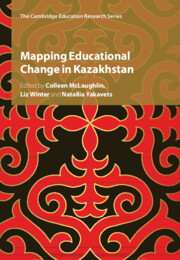Book contents
- Mapping Educational Change in Kazakhstan
- Mapping Educational Change in Kazakhstan
- Copyright page
- Dedication
- Contents
- Figures
- Tables
- Contributors
- Preface
- Acknowledgements
- Introduction
- Part I Foundations of Scaling Up
- Part II Piloting Initiatives and Scaling Up to the Whole System
- Part III Evidence of Implementation
- 12 The Aims and Methods of Evidence Collection
- 13 Regional Case Study 1
- 14 Regional Case Study 2
- 15 Regional Case Study 3
- 16 Beyond Piloting
- Conclusions
- Select Bibliography: School-Level Educational Reforms in Kazakhstan, 2011–2022
- Index
- References
12 - The Aims and Methods of Evidence Collection
Introductory Comments on Part III
from Part III - Evidence of Implementation
Published online by Cambridge University Press: 09 November 2023
- Mapping Educational Change in Kazakhstan
- Mapping Educational Change in Kazakhstan
- Copyright page
- Dedication
- Contents
- Figures
- Tables
- Contributors
- Preface
- Acknowledgements
- Introduction
- Part I Foundations of Scaling Up
- Part II Piloting Initiatives and Scaling Up to the Whole System
- Part III Evidence of Implementation
- 12 The Aims and Methods of Evidence Collection
- 13 Regional Case Study 1
- 14 Regional Case Study 2
- 15 Regional Case Study 3
- 16 Beyond Piloting
- Conclusions
- Select Bibliography: School-Level Educational Reforms in Kazakhstan, 2011–2022
- Index
- References
Summary
Chapter 12 is a brief chapter that sets out the research aims, design and processes of several collaborative research projects conducted by a large team of researchers from the University of Cambridge and Nazarbayev University. It covers the three-year period from 2018 to 2020 to describe the rationales and methods used for data collection alongside the philosophies of reporting applied in forming three regional case studies. It ends by signalling how the case studies and earlier research findings from 2018 combine to allow for contrasts between regions and layers in the educational system that inform on the variations and commonalities found pursuant to systemic educational reform.
- Type
- Chapter
- Information
- Mapping Educational Change in Kazakhstan , pp. 205 - 210Publisher: Cambridge University PressPrint publication year: 2023

